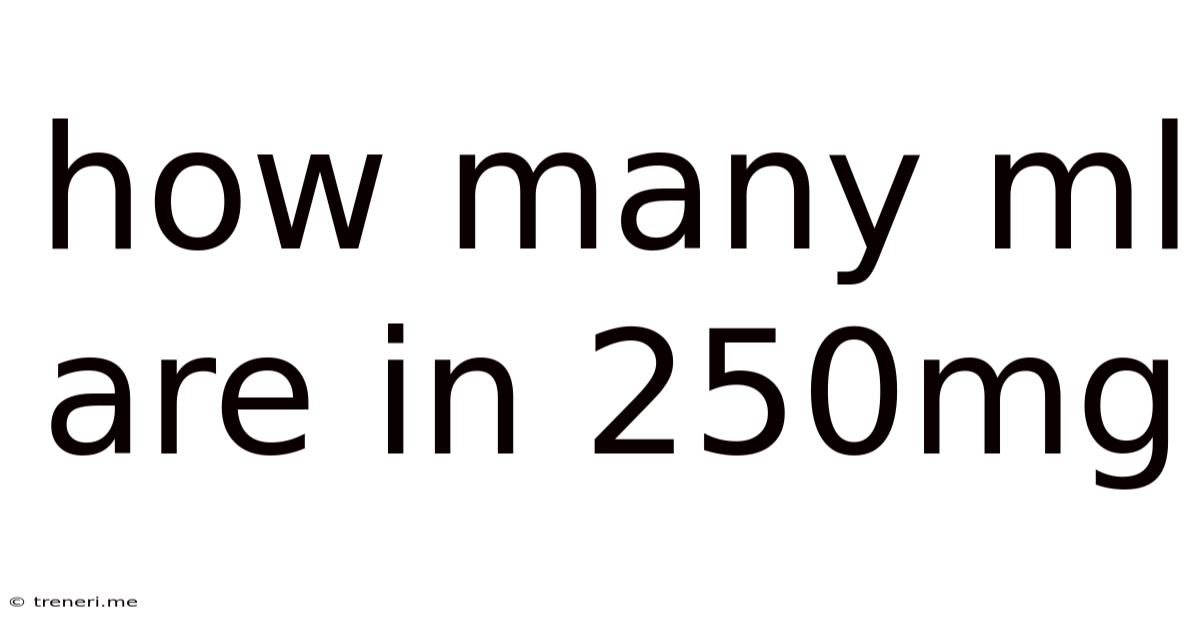How Many Ml Are In 250mg
Treneri
May 14, 2025 · 4 min read

Table of Contents
It's impossible to answer "How many ml are in 250mg?" without knowing the density of the substance. Milliliters (ml) measure volume, while milligrams (mg) measure mass. They are not directly interchangeable. Think of it like this: a kilogram of feathers takes up much more space (has a larger volume) than a kilogram of lead, even though they have the same mass.
This article will explore the relationship between mass (mg) and volume (ml), explain why you can't directly convert between them, and provide examples to illustrate the concept. We will also delve into the importance of understanding density, its application in various fields, and how to perform the necessary calculations when dealing with conversions involving mass and volume.
Understanding the Fundamental Difference: Mass vs. Volume
Before we delve into the specifics, let's clarify the fundamental difference between mass and volume:
-
Mass: Mass is the amount of matter in an object. It's a measure of inertia – the resistance of an object to acceleration. We typically measure mass in grams (g) or milligrams (mg).
-
Volume: Volume is the amount of three-dimensional space occupied by an object. We commonly measure volume in liters (L) or milliliters (ml).
The key takeaway is that mass and volume are not inherently related. A small mass can occupy a large volume, and vice versa, depending on the density of the substance.
The Crucial Role of Density
Density is the key to bridging the gap between mass and volume. Density is defined as the mass per unit volume of a substance. The formula is:
Density (ρ) = Mass (m) / Volume (V)
This formula allows us to convert between mass and volume if we know the density of the substance. Rearranging the formula, we can solve for volume:
Volume (V) = Mass (m) / Density (ρ)
Therefore, to answer "How many ml are in 250mg?", we need the density of the substance measured in mg/ml or g/ml (grams per milliliter).
Examples Illustrating the Concept
Let's illustrate this with a few examples:
Example 1: Water
The density of water is approximately 1 g/ml (or 1000 mg/ml). If we have 250 mg of water, we can calculate the volume:
V = m / ρ = 250 mg / 1000 mg/ml = 0.25 ml
Therefore, 250 mg of water occupies a volume of 0.25 ml.
Example 2: Ethanol (Alcohol)
The density of ethanol is approximately 0.789 g/ml (or 789 mg/ml). If we have 250 mg of ethanol, the calculation would be:
V = m / ρ = 250 mg / 789 mg/ml ≈ 0.317 ml
Notice that the same mass (250 mg) occupies a slightly larger volume in ethanol than in water because ethanol is less dense.
Example 3: A Hypothetical Substance
Let's consider a hypothetical substance with a density of 2 g/ml (or 2000 mg/ml). For 250 mg of this substance:
V = m / ρ = 250 mg / 2000 mg/ml = 0.125 ml
This shows that a higher density results in a smaller volume for the same mass.
Practical Applications of Density
Understanding density is crucial in many fields:
-
Medicine: Calculating drug dosages often involves considering the density of the medication to determine the correct volume to administer.
-
Chemistry: Density is a fundamental property used in many chemical calculations and experiments.
-
Engineering: Engineers use density to calculate the weight and strength of materials in structural designs.
-
Physics: Density plays a significant role in fluid mechanics and buoyancy calculations.
Searching for the Density: Where to Find the Information
To accurately convert 250mg to ml, you must find the density of the specific substance you're working with. This information can typically be found in:
-
Scientific literature: Research papers, textbooks, and handbooks often provide density values for various substances.
-
Chemical databases: Online databases like the NIST Chemistry WebBook contain comprehensive data on the properties of chemicals, including density.
-
Material safety data sheets (MSDS): MSDS provide detailed information about the properties and hazards of chemicals, including density.
Conclusion: The Importance of Context
The question "How many ml are in 250mg?" cannot be answered without knowing the density of the substance. The relationship between mass and volume is intrinsically linked to density. Remember the formula: Volume = Mass / Density. Always ensure you have the correct density value before attempting any conversion. The examples provided illustrate how different densities result in different volumes for the same mass. Understanding this fundamental concept is crucial for accurate calculations in various scientific and engineering applications. Always consult reliable sources for density information to ensure your calculations are accurate and safe.
Latest Posts
Latest Posts
-
1 Bar Is How Much Psi
May 14, 2025
-
What Percentage Of 90 Is 27
May 14, 2025
-
Find The Gcf Of 78 And 86
May 14, 2025
-
What Is 21 Out Of 25 As A Grade
May 14, 2025
-
Cuantos Son 16 Onzas En Mililitros
May 14, 2025
Related Post
Thank you for visiting our website which covers about How Many Ml Are In 250mg . We hope the information provided has been useful to you. Feel free to contact us if you have any questions or need further assistance. See you next time and don't miss to bookmark.